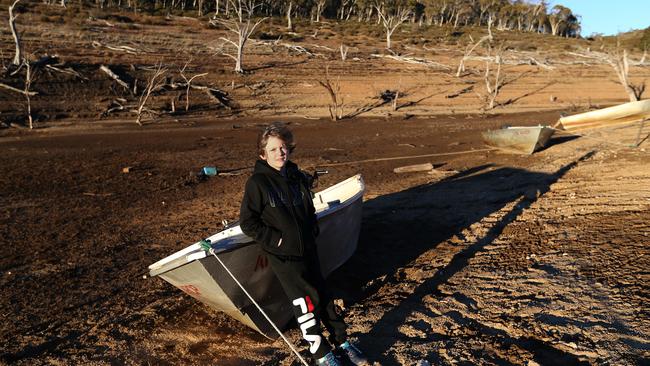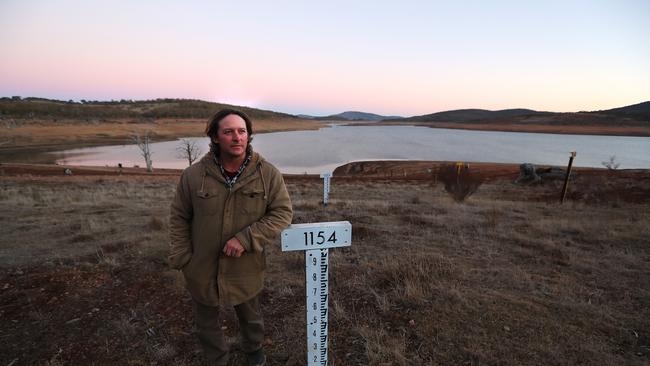No rain and no Hazelwood are no good for hydro scheme
Snowy Hydro’s biggest storage dam has fallen to less than 25 per cent capacity due to poor rains and high electricity generation.

Snowy Hydro’s biggest storage dam has fallen to less than 25 per cent capacity due to poor rains and high electricity generation following the closure of the Hazelwood coal power station in Victoria.
Lake Eucumbene is now at its lowest level since 2010 and on its way to a repeat of 2007 when electricity generation had to be stopped in favour of a heavily polluting fossil-fuel generator in Victoria.
Snowy Hydro is wholly owned by the federal government and has big plans to expand, with Snowy 2.0 to be a hydro-electric back-up for the nation’s wind turbines and solar panels.
Pumped hydro uses the same water pumped up and down the hill. But little attention has been paid to Snowy Hydro’s reliance on the weather.
Alan Basford, who has been at Anglers Reach Caravan Park on the shores of Lake Eucumbene for 50 years, said things were becoming desperate.
“We have been very concerned for a long while,” Mr Basford told The Australian.He stopped pumping water for the park three months ago and said what usually was a 3km stretch of water out the front of his property was now “just a river”.
The fishing is still good but visitors can no longer get to the water. “We haven’t had any rain for a long time but it’s going down like mad because they are generating electricity,” Mr Basford said.
“They are generating all the time and using water like it is going out of style.”
Snowy Hydro chief executive Paul Broad said the company had increased its electricity production to take advantage of tight market conditions.

“We have generated more energy recently with Hazelwood retiring, which has impacted on our overall storage levels,” Mr Broad said.
He said Eucumbene was the scheme’s largest storage dam and played “an important role in regulating the highly variable flows that the scheme receives over multiple seasons and years”.
“It rises and falls over much longer periods than many of our other reservoirs,” he said. “Our storages are usually at their lowest coming into winter and we expect to see them rise when we get the spring run-off later this year.’’
Lake Eucumbene was at 24 per cent of total storage, which Mr Broad said was low “but by no means the lowest levels we’ve operated under”.
The ability of Snowy Hydro to produce electricity is very much dependent on its water reserves, which in turn are dependant on steady rainfall and minimal drought conditions.
Weather events such as El Nino have a dramatic impact on rainfall and Snowy Hydro’s capacity to produce electricity.
Between 2000 and 2010 Australia experienced three separate El Nino events that severely affected national rainfall.
Electricity supplies on the national energy market have tightened sharply since then and Snowy Hydro has been a much- needed source of generation.
Heavy rains are required to replenish the Eucumbene reservoir, but the Bureau of Meteorology winter outlook is for below-average rainfall for NSW, South Australia, northern Victoria and western parts of Western Australia.
The bureau said the shift towards drier conditions was “particularly strong for areas around the Murray-Darling Basin and eastern NSW, which have a 70-80 per cent chance of below-average rainfall”.
Snowfall was forecast to be below average early in the season.

Of more concern was the “greater than usual chance” of El Nino forming later this year.
Australian Power Project chief executive Nathan Vass said the low dam levels highlighted the shortcomings of hydro as a means of solving energy market problems. “Much like solar and wind, it cannot be considered baseload power as it is still reliant on rain and snowfalls,” Mr Vass said.
Mr Broad said Snowy Hydro constantly monitored inflows and weather forecasts to plan for current and future operations. “For more than 60 years we’ve successfully managed the Snowy scheme through periods of high inflows and very severe drought,” he said.
“While we have a long-term average output, we operate through cycles. We tend to generate more energy in years of tight supply and operate less (allowing for our storages to refill) in years when the market is oversupplied.
“For example, we have generated more energy recently with Hazelwood retiring, which has impacted on our overall storage levels.”
Snowy Hydro has a range of gas and diesel assets to respond to market demands and cover contracted positions. Mr Broad said pumped hydro would enable the company to reuse available water within a closed system before water was released as part of the strict conditions of the company’s water licence for use by downstream water users and for environmental flows.



